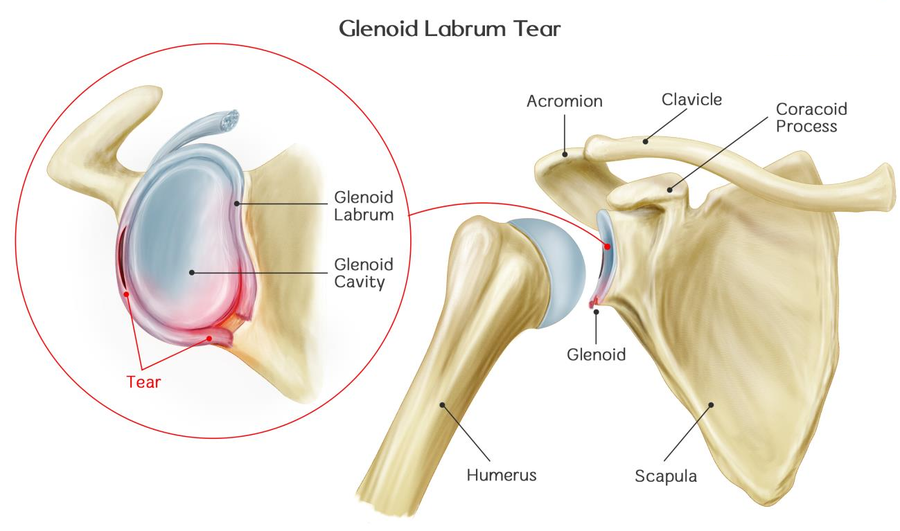A shoulder labrum tear can be painful. It may limit movement, strength and restrict athletic activities. Leading causes include degenerative issues, wear and tear, and traumatic shoulder injury. Its debilitating effects can impact everyday activities and sports performance. Many times labrum tear shoulder treatment can decrease pain, increase active range of motion, and improve functional capacity and endurance.
Overview: Shoulder Labrum Tear
Shoulder tears target the cartilage connected to the cup-shaped rim around the shoulder socket. The rubbery tissue prevents the humeral head (ball) from dislocating from the glenoid (socket) during shoulder movement. Additionally, its presence promotes a free range of motion and smooth movement. All this makes lifting objects, throwing things, and other upper arm movements easier.
There are two types of shoulder labral tears; Bankart tears and Superior Labrum Anterior to Posterior (SLAP) tears. The former occurs due to shoulder dislocation, causing anterior/posterior instability that affects the front or back of your body.

On the other hand, SLAP tears affect the front side of your upper arm, specifically the connection point between your biceps and shoulder.
Labrum tears can occur due to overuse, shoulder injury, or sudden trauma. When that happens, you may experience shoulder pain, stiffness, and limited mobility. The affected labrum can increase the chances of shoulder dislocation and fracture.
Early intervention with labrum tear treatment and physical therapy exercises prevent chronic shoulder pain. It also mitigates the risk of shoulder surgery/replacement.
Symptoms
Common symptoms of shoulder labral tears include:
- Stiffness
- Locking, catching or popping sound when you move the shoulder
- Shoulder pain experienced at night or when you perform everyday activities
- Reduced range of motion
- Fatigue
- Difficulty in lifting/carrying heavy objects
- Feeling unstable
Causes
Leading causes of shoulder labral tears include:
- Acute trauma, leading to fractures or dislocated shoulder
- Overuse of the shoulder joint
- Repetitive motions i.e. swinging a bat, lifting heavy objects, throwing objects, etc.
- A sudden or forceful movement that causes the overstretching
- High-risk activities include sports and manual labor
- Degenerative issues (i.e. excessive wear and tear due to old age)
Diagnosis
Our physical therapists start labrum tear treatment with a comprehensive physical examination. We compare your current condition with medical reports, past injury, and ongoing pain patterns. You will have to perform specific shoulder movements. These can help us determine the severity of your condition as we discuss how it impacts your daily activities.
Apart from this, the detailed test allows us to rule out other causes of labral damage and shoulder pain. We assess how your scapula and shoulder move with certain movements to identify muscle impairments and strength limitations. Besides this, we assess coordination and proprioception and document functional limitations.
Treatment
Our shoulder labral physical therapy focuses on individual symptoms and lifestyle requirements. This personalized approach improves chances of effectiveness and eases your transition to regular routine post shoulder injury or degenerative wear and tear.
The treatment plan includes physical therapy exercises for home. We select a goal-oriented combination of stretching and strengthening labrum tear physical therapy exercises, which supports muscle strength, increases endurance, and improves the optimal level of movement.
Moreover, we teach functional training labrum tear physical therapy exercises based on daily activities and recreational interests. For instance, professional athletes and fitness enthusiasts will be taught how to retain optimal functioning and stamina along with prevention techniques for a potential labral tear. Many time the Neubie Neufit protocol is used to improve strength and decrease pain faster than traditional methods. Office workers and individuals who work on laptops/desktops for a significant part of the day shall learn postural alignment and ergonomic training.
Our additional guidance enables you to engage in your favorite pastimes and continue routine activities without worrying about relapse.
Contact us or call 201-773-8851 for further inquiries and consultation regarding shoulder labrum tear physical therapy exercises and treatment.

